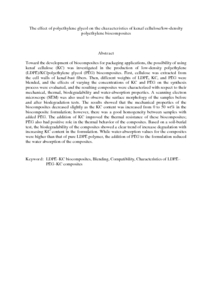Citation
Tajeddin, Behjat and Abdul Rahman, Russly and Abdullah, Luqman Chuah
(2010)
The effect of polyethylene glycol on the characteristics of kenaf cellulose/low-density polyethylene biocomposites.
International Journal of Biological Macromolecules, 47 (2).
pp. 292-297.
ISSN 0141-8130
Abstract
Toward the development of biocomposites for packaging applications, the possibility of using kenaf cellulose (KC) was investigated in the production of low-density polyethylene (LDPE)/KC/polyethylene glycol (PEG) biocomposites. First, cellulose was extracted from the cell walls of kenaf-bast fibers. Then, different weights of LDPE, KC, and PEG were blended, and the effects of varying the concentrations of KC and PEG on the synthesis process were evaluated, and the resulting composites were characterized with respect to their mechanical, thermal, biodegradability and water-absorption properties. A scanning electron microscope (SEM) was also used to observe the surface morphology of the samples before and after biodegradation tests. The results showed that the mechanical properties of the biocomposites decreased slightly as the KC content was increased from 0 to 50 wt% in the biocomposite formulation; however, there was a good homogeneity between samples with added PEG. The addition of KC improved the thermal resistance of these biocomposites; PEG also had positive role in the thermal behavior of the composites. Based on a soil-burial test, the biodegradability of the composites showed a clear trend of increase degradation with increasing KC content in the formulation. While water-absorption values for the composites were higher than that of pure LDPE polymer, the addition of PEG to the formulation reduced the water absorption of the composites.
Download File
![[img]](http://psasir.upm.edu.my/12252/1.hassmallThumbnailVersion/The%20effect%20of%20polyethylene%20glycol%20on%20the%20characteristics%20of%20kenaf%20cellulose.pdf)  Preview |
|
PDF (Abstract)
The effect of polyethylene glycol on the characteristics of kenaf cellulose.pdf
Download (148kB)
| Preview
|
|
Additional Metadata
Actions (login required)
 |
View Item |

